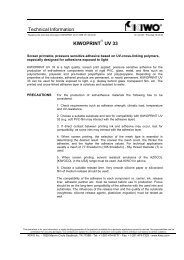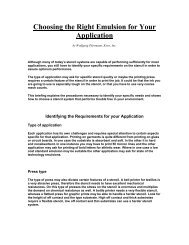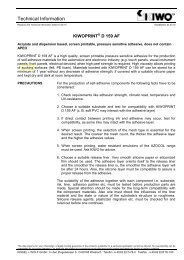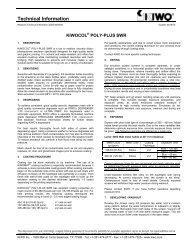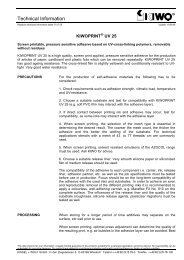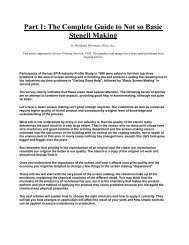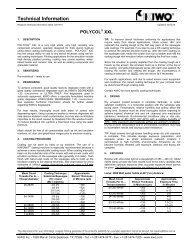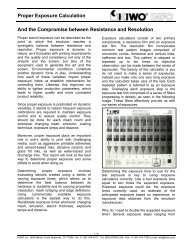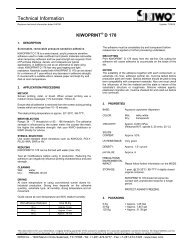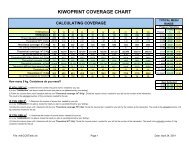You also want an ePaper? Increase the reach of your titles
YUMPU automatically turns print PDFs into web optimized ePapers that Google loves.
Technical Information<br />
Created: 09/16/10<br />
POLYCOL ® THICK-COAT<br />
1. DESCRIPTION<br />
POLYCOL ® THICK-COAT is a very high solids and viscosity, fast<br />
exposing, pre-sensitized red SBQ emulsion specially formulated for<br />
creating <strong>thick</strong> stencils and for drip-free <strong>coat</strong>ing on coarse mesh<br />
counts. POLYCOL ® THICK-COAT is plastisol, water and UV<br />
resistant. It also has decent solvent resistance.<br />
POLYCOL ® THICK-COAT builds up quickly and has exceptional edge<br />
definition and resolution. Unlike most emulsions used for making <strong>thick</strong><br />
stencils, POLYCOL ® THICK-COAT develops (washes out) very<br />
quickly saving valuable processing time. POLYCOL ® THICK-COAT’s<br />
solvent resistance prevents solvents from “locking in” the emulsion<br />
making reclaiming easier.<br />
TIP: To optimize the emulsion’s resistance to water-based and<br />
discharge ink systems, be sure the emulsion is extremely dry at the<br />
time of exposure. Also, select the longest possible exposure time to<br />
enhance durability and to avoid pre-mature stencil breakdown.<br />
NOTE: For maximum resistance to aggressive ink systems, the use<br />
of Diazo D and a stencil hardener may be required for longer print<br />
runs. See SENSITIZING and POST HARDENING below for more<br />
information.<br />
2. SENSITIZING<br />
Pre-sensitized -- ready to use. If needed, Diazo D (sold separately)<br />
may be used when printing with water-based and discharge ink<br />
systems.<br />
3. DEGREASING<br />
To achieve consistent, good quality stencils, degrease mesh with a<br />
good quality commercial degreaser such as <strong>KIWO</strong>’s DEGREASER<br />
1:20 CONCENTRATE or ULTRA PREP. For degreasers used in<br />
automatic equipment, <strong>KIWO</strong> offers a specially formulated machine<br />
grade degreaser <strong>KIWO</strong>CLEAN DEGREASER 1:40 CONCENTRATE.<br />
See separate Technical Information sheets for further details<br />
regarding <strong>KIWO</strong>’s degreasers.<br />
For best results, thoroughly brush both sides of screen with<br />
degreasing agent. Using a pressure washer to remove degreaser will<br />
help remove stubborn mesh contaminates, but may also re-introduce<br />
impurities to the mesh caused by blowback from the washout booth.<br />
To reduce blowback risk, perform a final flood rinse using low water<br />
pressure.<br />
Mesh should be free of all contaminates such as ink and emulsion<br />
residues, oil, dust, and ghost/haze images prior to emulsion <strong>coat</strong>ing.<br />
4. COATING PROCEDURE<br />
Coating can be done manually or by machine. The use of a<br />
<strong>KIWO</strong>MAT ® <strong>coat</strong>ing machine is especially recommended because it<br />
achieves a more reproducible <strong>coat</strong>ing result. When <strong>coat</strong>ing manually,<br />
begin on the substrate side of the screen with wet-on-wet <strong>coat</strong>s until<br />
emulsion surfaces on the squeegee side (generally 2 <strong>coat</strong>s when<br />
using round edged <strong>coat</strong>ing trough). Then finish with wet-on-wet <strong>coat</strong>s<br />
on the squeegee side to build up the emulsion <strong>coat</strong>ing to the desired<br />
<strong>thick</strong>ness depending on the printing requirements.<br />
POLYCOL ® THICK-COAT has excellent <strong>coat</strong>ing properties on mesh<br />
counts of 40-305 threads per inch (16-120 threads per cm). For<br />
standard stencil <strong>thick</strong>ness, the following <strong>coat</strong>ing techniques are<br />
recommended using a round (2 - 2.5 mm) edged <strong>coat</strong>ing trough:<br />
40-86 tpi (16-34 tpcm): 2-1 wet-on-wet<br />
110-156 tpi (43-61 tpcm): 2-1 wet-on-wet<br />
195-305 tpi (77-120 tpcm): 2-1 wet-on-wet<br />
For <strong>thick</strong> stencil applications, and due to varied screen room<br />
equipment and conditions, the correct <strong>coat</strong>ing technique for your<br />
process must be determined through <strong>coat</strong>ing tests. Contact <strong>KIWO</strong> for<br />
more specific <strong>coat</strong>ing techniques.<br />
The following table can be used only as a very general guide:<br />
Mesh tpi Coating Technique* Stencil Thickness<br />
83-70 µm 2-2 ~ 125 µm<br />
83-70 µm 2-3 ~ 180 µm<br />
83-70 µm 2-4 ~ 235 µm<br />
83-70 µm 2-5 ~ 300 µm<br />
* Coated with a round (2.5 mm diameter) <strong>coat</strong>ing trough<br />
5. DRYING<br />
Dry emulsion <strong>coat</strong>ed screens in complete darkness, or under<br />
safelight conditions, in a horizontal position with the substrate side<br />
facing down. Temperature, relative humidity and airflow affect the<br />
drying time. Screens must be dried thoroughly before exposing to<br />
achieve highest chemical (ink and ink cleaners) and mechanical<br />
(abrasion) resistance. Environmental conditions play a vital role.<br />
Temperatures of 86°-104°F (30°-40°C) with a relative humidity of<br />
30% - 50% maximum and moderate airflow are optimum conditions.<br />
Drying at room temperature and in uncontrolled conditions may lead<br />
to inconsistent results and varying screen resistance.<br />
TIP: Keep screens and all screen handling areas dry until exposure<br />
is complete. This includes storage, exposure preparation, and<br />
exposure areas, as photo emulsions reabsorb moisture if<br />
reintroduced to high humidity environments. Emulsions do not<br />
become humidity resistant until exposure, washout and drying are<br />
complete.<br />
6. EXPOSING<br />
Expose with ultra-violet light at a wavelength of 350 – 420 nm. Metal<br />
halide lamps provide the best results. Due to the many variables that<br />
determine optimum exposure time, accurate exposure times cannot<br />
be given. The following examples are offered as a guide only.<br />
Lamp: 5000 Watt metal halide at 40” (1m) distance:<br />
Mesh Count<br />
tpi (tpcm)<br />
Mesh Color<br />
Coating<br />
Technique<br />
Exposure Time<br />
60-140 (24-140) White 2-1 ~ 40 sec.<br />
83-70 (32-70) Yellow 2-4 ~ 2 min.<br />
This data sheet is for your information, a legally binding guarantee of the product's suitability for a peculiar application cannot be derived. No responsibilities can be<br />
undertaken for occurring damages. Our products are subject to a continuous production and quality control and leave our factory in perfect condition.<br />
<strong>KIWO</strong> Inc. - 1929 Marvin Circle Seabrook, TX 77586 - Tel: +1-281-474-9777 - Fax: +1-281-474-7325 - www.kiwo.com
Technical Information<br />
POLYCOL ® THICK-COAT<br />
Page 2 of 2<br />
Correct exposure times for your equipment and mesh selection must<br />
be determined through exposure tests using an exposure calculator<br />
such as the <strong>KIWO</strong> ® ExpoCheck.<br />
Under-exposed screens feel slimy on the squeegee side during<br />
developing. At correct exposure time, the screen is not slimy.<br />
Overexposure leads to loss of small details. Correctly exposed<br />
screens will withstand high water pressure during washout.<br />
Please contact <strong>KIWO</strong> if you have further questions regarding<br />
exposure time.<br />
7. DEVELOPING / WASHOUT<br />
Depending on the mesh count and stencil <strong>thick</strong>ness one of the two<br />
following techniques work well:<br />
High pressure developing: Wet both sides of the screen thoroughly<br />
with water, then after a short dwell time; wash out screen from the<br />
substrate side of the screen using a power washer (~1,500 psi) on<br />
fan spray setting at 12-18” distance until image if fully developed.<br />
Briefly rinse squeegee side to remove any remaining emulsion<br />
residue. Vacuum or blot excess water from screen.<br />
Dip tank pre-soak technique: Commonly used for <strong>thick</strong> stencils used<br />
for high density printing, exposed screens can alternatively be placed<br />
into water dip tank for a few minutes to pre-soak and soften the<br />
unexposed emulsion. Remove screens after 3-5 minutes and begin<br />
high pressure developing technique described above.<br />
8. POST-EXPOSURE<br />
Post-exposing the screen after developing and drying is not very<br />
effective. To improve the resistance ~10-15% the post-exposure time<br />
needs to be 4x the original exposure time. Exposing the screen fully<br />
with the primary exposure offers better resistance than under<br />
exposing initially, then post-exposing to improve resistance. Post<br />
exposure is most often used for long printing runs when water based<br />
and/or abrasive inks are used.<br />
9. POST-HARDENING (CHEMICALLY)<br />
The emulsion can be chemically post-hardened using one of <strong>KIWO</strong>’s<br />
stencil hardeners. Stencil hardeners can be classified as reclaimable<br />
or un-reclaimable. If reclaiming ability is desired, use <strong>KIWO</strong><br />
HARDENER WR or HARDENER HP.<br />
If a permanent un-reclaimable stencil is desired, for example when<br />
cataloging screens for future use, or when aggressive inks are used<br />
for very large print runs, use <strong>KIWO</strong> HARDENER K. See separate<br />
Technical Information sheets for further details regarding <strong>KIWO</strong>’s<br />
stencil hardeners.<br />
10. BLOCKOUT / TOUCH-UP<br />
Retouching and blocking out can be done with <strong>KIWO</strong>’s BLOCKOUT,<br />
RED BLOCKOUT or <strong>KIWO</strong>FILLER SR 401 NV. For a water<br />
resistance stencil, block out and retouch with <strong>KIWO</strong>FILLER SWR 22<br />
or use POLYCOL ® THICK-COAT (dry thoroughly and re-expose<br />
completely prior to using stencil hardeners). See separate Technical<br />
Information sheets for further details regarding <strong>KIWO</strong>’s blockouts.<br />
11. RECLAIMING<br />
POLYCOL ® THICK-COAT can be reclaimed with <strong>KIWO</strong>’s STENCIL<br />
REMOVER 1:20 CONCENTRATE. Before reclaiming, ensure the screen<br />
is completely cleaned of ink or ink cleaning chemical residues. If<br />
water beads up on the stencil, residues are still present. If this is the<br />
case, degrease the screen again prior to reclaiming for best results.<br />
For best results, work both sides of the screen i.e. apply stencil<br />
remover, brush, and pressure wash both sides of the screen. After<br />
applying stencil remover, a short dwell time may be used prior to<br />
pressure washing to allow more working time for the stencil remover<br />
especially when using coarser meshes and/or <strong>thick</strong>er stencils.<br />
CAUTION: Never allow stencil removers to dry prior to removal, as<br />
the emulsion will become locked into the mesh and virtually<br />
impossible to remove. See separate Technical Information sheets for<br />
further details regarding <strong>KIWO</strong>’s stencil removers.<br />
12. HAZE REMOVING<br />
To remove emulsion haze or ghost images left from the ink, use<br />
<strong>KIWO</strong>’s HAZE REMOVER, FAST LIQUID HAZE REMOVER, or<br />
MEGA CLEAN ACTIVE.<br />
For best results, HAZE REMOVER should be applied to a dry<br />
screen, then allowed to completely dry on the screen. For more<br />
effective ink ghost removal, HAZE REMOVER can be used in<br />
conjunction with <strong>KIWO</strong>CLEAN ® CONCENTRATED INK WASH or<br />
ULTIMATE INK WASH to re-activate dried HAZE REMOVER.<br />
Active components in FAST LIQUID HAZE REMOVER and MEGA<br />
CLEAN ACTIVE work in approximately five minutes and effectively<br />
remove both emulsion haze and ink ghost simultaneously. See<br />
separate Technical Information sheets for further details regarding<br />
<strong>KIWO</strong>’s haze removers.<br />
Haze removers, like ink washes and stencil removers should be<br />
worked into the screen mesh from both sides of the screen before<br />
removing for maximum effectiveness.<br />
13. PHYSICAL PROPERTIES<br />
Viscosity:<br />
Approx.60,000 mPas<br />
Solids Content: approx.: 51%<br />
Color:<br />
Storage:<br />
Potlife:<br />
Pre-<strong>coat</strong>ed screens:<br />
Freezing:<br />
VOC:<br />
TLV:<br />
Light Red<br />
1 year at 68°F/20°C<br />
1 year at 68°F/20°C<br />
8 weeks in complete darkness<br />
at 68°F/20°C or 1-3 weeks<br />
when using diazo D<br />
Protect against freezing<br />
None<br />
N/A<br />
HMIS rating: Health – 1<br />
Flammability – 0<br />
Reactivity – 0<br />
14. PACKAGING<br />
1 US Quart, 1 US Gallon, 5 US Gallons, 55 US Gallon Drum.<br />
15. ADDITIONAL INFORMATION<br />
For additional product information, please visit our web site at<br />
www.kiwo.com. All products mentioned in this technical data<br />
sheet are available through <strong>KIWO</strong> Inc. and its distributor network. For<br />
further information contact your authorized <strong>KIWO</strong> distributor or <strong>KIWO</strong><br />
direct.<br />
Thank you for choosing <strong>KIWO</strong>.




